River Voices Story Four - Monitoring the Manatees | |
| Story One | Story Two | Story Three | Story Four | Story Five | |
| Visit the main River Returns web site >> | |
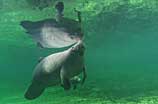 © Karst Productions, Inc. |
Narrator: Many living things call the St. Johns River home, ranging from the ever-present great blue heron, osprey and alligator to the majestic bald eagle. However, there's one animal that is difficult to spot in the St. Johns' dark waters, but its presence is well-noted along the river's length. It's the manatee, Florida's poster child for species protection. |
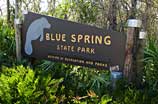 |
Narrator: In the winter, the manatee's numbers become apparent when they seek refuge at Blue Spring State Park, about 35 miles north of Orlando. And when they arrive, park ranger Wayne Hartley is there to greet them. |
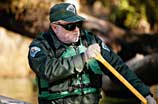 |
Wayne Hartley: We got some coming down towards us. Come here. Sometimes one of them will suddenly see me and give an alarm and nobody looks, they just all run. And then they'll come floating down and they'll stop and look at me and say "Is this what it was about? I'm not afraid of him." And then they'll turn around and go back. |
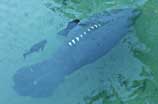 |
Narrator: Their fear, however, is understandable. Virtually every manatee has scars or fresh cuts from being hit by boats. |
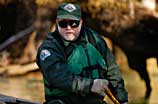 |
Wayne Hartley: Marguerito looks like he went out, got hit during the January warm spell and then a fungus got into the boat strike. I need to see his other side. Come here boy. |
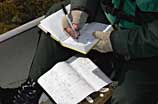 |
Narrator: Hartley has been monitoring manatees for more than two decades. |
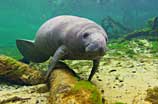 © Karst Productions, Inc. |
Wayne Hartley: I've been counting manatees about 25 years. Many years ago, I was given a wildlife book by my grandmother Chandler and I'd flip through and look at the pictures. If I saw something interesting, I'd read about it. I saw a picture of a manatee and I could not believe that such an exotic, strange animal existed in my country. It should have been in Africa or South America somewhere. |
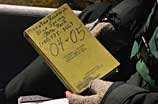 |
Narrator: Hartley's knowledge of manatee behavior grew as did the recognition of Blue Spring as a sanctuary for the marine mammals. |
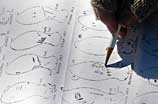 |
Wayne Hartley: And we had directives to do everything we could to help the manatee research. Which is just primarily life history. Who comes back every year. How long do they live? When do they die? If one of them dies anywhere around here, I try to get out and see it, because it's probably one that I know. Keep track of the calves when they are born. Check calf survival. Who's pregnant. Who's not. Who leaves here pregnant, comes back without a calf. |
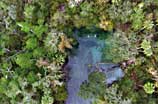 |
Narrator: Springs are important manatee habitats because the water flowing up from the ground is a constant 70 to 72 degrees. When the St. Johns River temperature drops below 68 degrees manatees can become stressed by the cold and die. |
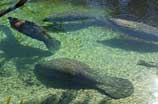 |
Wayne Hartley: In the summer we have huge crowds trying to stay cool. In the winter we have huge crowds of manatees trying to stay warm in the same water. |
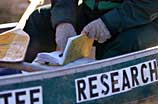 |
Narrator: For years, Hartley painstakingly documented the return of the manatees, their condition and the ebb and flow of cold river water in Blue Spring's run. |
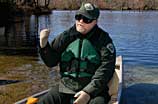 |
Wayne Hartley: Everything is based on temperature. How many manatees come in is based on how cold the river is. But I also noticed that the colder the river was the further the river came in. |
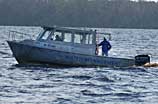 |
Narrator: His observations would later help water managers who are required by law to set minimum flows and levels for the spring. This would ultimately impact how much water can be pumped from the aquifer while ensuring a minimum flow level that would support the manatees. |
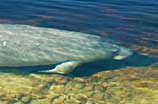 |
Wayne Hartley: What they are afraid of is as the flow goes down it will give the cold river water an opportunity to push in, leaving less room for hopefully more and more manatees. In other words they are increasing. So we want to have as much room for manatees as we possibly can. |
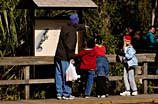 |
Narrator: Visitors from afar come to see the more than one hundred manatees that make Blue Spring their refuge. But Hartley cautions that there needs to be more sanctuaries like Blue Spring. |
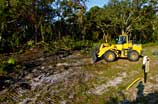 |
Wayne Hartley: But if we keep destroying habitat, we'll never increase beyond a certain point. The idea is not just to have enough habitat for the ones that are surviving now but to have habitat for the ones we hope to have in the future if they are saved and do increase. |
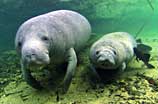 © Karst Productions, Inc. |
Narrator: For now, Hartley is busy standing watch over the manatees that make Blue Spring their wintertime retreat. |
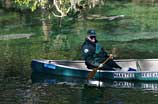 |
Wayne Hartley: Mona's looking at us. Marguerito lost a flipper to line entanglement. |
River Voices
The River Returns
Stories of the Great St. Johns
The River Returns web documentary, Copyright © Fusionspark Media, Inc. All Rights Reserved.
All Photos © 2005 Russell Sparkman/Fusionspark Media, Inc., unless otherwise noted.
All Photos © 2005 Russell Sparkman/Fusionspark Media, Inc., unless otherwise noted.
